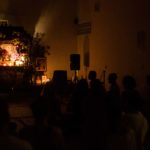Monday Morning Greetings #36 – Giving Birth to Devotion
Dhanurdhara Swami September 5th, 2016
I like the analogy of devotional activities giving birth to devotion like a mother gives birth to a child. One day there is no child and suddenly one is born. In the same way, although bhakti is generally a gradual process, bhakti can one day suddenly manifest or be born as a result of powerful spiritual activities.
In one song that highlights the potency of honoring special days of the Lord, like ekādaśī and Janmāṣṭamī, Śrīla Bhaktivinoda Ṭhākura points out the possibility of such an unexpected surge in bhakti. He sings:
mādhava-tithi (the days of Lord Hari) bhakti-jananī (gives birth to devotion)
I would like to share with you my realizations of this principle in relation to our first Janmāṣṭamī here in the beautiful Shyam Ashram in Cali, both in this short post and the accompanying pictures to the event. First some background:
Our ashram is maintained by yoga and retreats, but we have Gaura Nitāi deities, and a mandatory morning program of maṅgala-ārati and japa for our small crew of resident teachers. There is plenty sat-saṅga, teaching and hearing śāstra (sacred texts), especially when either Kaustubha, Jaya Jagannātha or myself are here and quite substantial Gītā seminars by the trained residents when we are not present. The closest thing to Shyam Ashram would be The Bhakti Center in New York, a devotional cultural center that is increasingly attracting a professional class of people. By the location of our ashram and the type of outreach we do, we seem to cater to a very established class of people that have formed our growing congregation. The nice thing here is that, unlike many places, the well-to-do people here are generally pious Catholics, stable and family oriented, and thus naturally respectful and receptive to culture and people of devotion. Now the festival:
Although it was a first here, our festival was a typical Kṛṣṇa celebration. There were plentiful and stunning floral arrangements, a well-prepared bounty of tasteful foodstuffs offered to Kṛṣṇa, non-stop and melodious kīrtan, and a colorful abhiṣeka (ceremonial bath) of our Deities. I also gave a short talk to our first time participants explaining the relevance of the function. Most importantly the ashram residents and a core congregation were engaged non-stop throughout the day in devotional service preparing the elaborate celebration. My realization:
Flowers, food, and song offered in devotion embody the devotion that is created and offered with them. To see, taste, or hear them is thus not just a sensual experience. It is also an emotional or spiritual one because they project the potency of devotion that produced them. Our new time visitors were thus transformed by the overwhelming color, flavor, and sounds of our joyous celebration. I witnessed that and many also expressed that to me. The occasion was a substantial milestone for our project.
When I walked around Shyam Ashram early the next morning I saw Ximena (one of our directors), who worked tirelessly the day before the festival helping to prepare the festivities, sweeping and mopping the floor as she was chanting joyously. She has become dedicated in devotion, but her chanting this day had a special quality and depth. As she sang I could feel the extra devotion that had been born in her heart. I immediately thought of Bhaktivinoda’s song:
mādhava-tithi (the days of Lord Hari) bhakti-jananī (gives birth to devotion)
I thus became inspired to write this post. Enjoy the pictures!
- Monday Morning Greetings
- Comments(0)




































































